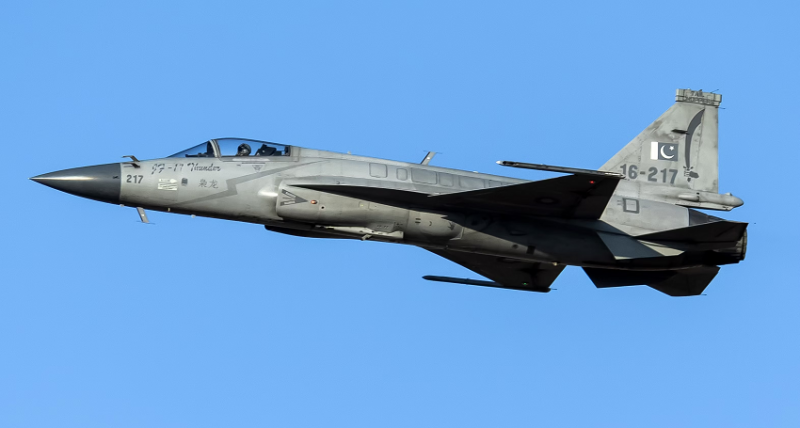
A recent photograph from the 2023 Pakistan Day Parade rehearsals has unveiled significant advancements in Pakistan’s military capabilities. The image shows a JF-17 Thunder Block II aircraft equipped with a Ra’ad-I air-launched cruise missile (ALCM). This is the first time this configuration has been publicly displayed, marking a noteworthy strategic development.
China has been instrumental in Pakistan's military modernization. The JF-17 Thunder, jointly developed by Pakistan Aeronautical Complex and China’s Chengdu Aircraft Industry Corporation, is set to replace the aging Mirage III and V aircraft in Pakistan’s air force. With over 130 operational JF-17s, this partnership highlights the deepening defense cooperation between the two countries.
FAS Confirms Ra’ad-I Missile on JF-17
The Federation of American Scientists (FAS) analyzed the image and confirmed the missile as a Ra’ad-I, Pakistan’s only nuclear-capable ALCM. According to the FAS report, "This was the first time such a configuration had been observed in public." The missile’s 'twin-tail' design distinguished it from the Ra’ad-II’s 'x-shaped' tail, introduced in 2017.
The FAS conducted a detailed comparison with previous versions of the Ra’ad missiles shown in Pakistan Day Parades from 2017 to 2024. Using advanced tools, they measured the missile length at approximately 4.9 meters, confirming it as a Ra’ad-I rather than the newer Ra’ad-II or the conventional anti-ship variant, Taimoor.
Ra'ad-I vs Ra'ad-II
Experts compared the observed missile with past displays of Ra'ad-I and Ra'ad-II. The Ra'ad-I features a 'twin-tail' design, while the Ra'ad-II has an 'x-shaped' tail. Using sophisticated measurement tools, analysts confirmed the missile length as 4.9 meters, consistent with Ra'ad-I specifications, thus confirming the missile on the JF-17 as a Ra’ad-I ALCM.
China's Role in Pakistan’s Military Advancements
China has been pivotal in aiding Pakistan’s military modernization. The JF-17 Thunder, developed jointly by Pakistan Aeronautical Complex and China’s Chengdu Aircraft Industry Corporation, is set to replace the outdated Mirage III and V aircraft in Pakistan’s air force. With over 130 operational JF-17s, this partnership signifies strong defense cooperation between the two nations.
Strategic Shift and Modernization
The integration of the Ra’ad-I on the JF-17 represents a significant strategic upgrade for Pakistan. Historically, Pakistan has relied on its Mirage aircraft for nuclear strike roles, but budget constraints have necessitated repairs and upgrades of these aging planes. The induction of the JF-17, equipped with Ra’ad-I missiles, is expected to replace the Mirage aircraft and enhance Pakistan’s nuclear deterrence capabilities.
Regional Implications and Impact on India
This development comes amidst a broader nuclear arms competition in South Asia involving India, China, and Pakistan. As India inducts Rafale jets capable of carrying nuclear weapons and advances its missile technology, Pakistan’s enhancements with the JF-17 and Ra’ad-I highlight the intensifying arms race. The development of short-range, lower-yield nuclear-capable systems by Pakistan raises concerns about regional stability and the potential for escalation in a conflict with India.
China and Pakistan have been collaborating in defense matters. Pakistan is also developing other short-range, lower-yield nuclear-capable systems like the NASR (Hatf-9) ballistic missile to counter conventional military threats from India. These advancements, coupled with rising regional tensions, raise concerns about an accelerated arms race and the potential for conflict escalation between India and Pakistan.
As of 2024, Islamabad holds 170 nuclear warheads, which are stored separately from their missiles and assembled only when necessary. This means that even if JF-17 jets are equipped with Ra’ad missiles, they are unlikely to carry nuclear warheads during patrols.
Pakistan's nuclear strategy focuses on countering India’s conventional and nuclear capabilities. Unlike India, which has a No First Use policy, Pakistan emphasizes smaller, tactical nuclear weapons to counter India’s superior conventional forces. Pakistan's warhead designs primarily use highly enriched uranium (HEU), produced at facilities in Kahuta and Gadwal, Punjab.
The revelation of the JF-17 Thunder Block II’s nuclear capabilities, supported by China, underscores Pakistan’s strategic shift in modernizing its air force. The integration of Ra’ad-I missiles significantly enhances Pakistan’s nuclear deterrence, impacting the regional power balance. As South Asia witnesses an accelerated arms race, the implications for regional stability and potential conflict escalation remain critical concerns.
Read More:
Russian Missile Again Strike on Odesa Injures Three, Damages Civilian Infrastructure
North Korea Claims Successful Test of New Multiwarhead Missile; South Korea Labels it a Failure
US Expedites Air Defense Interceptor Missiles to Ukraine Amid Increased Russian Attacks